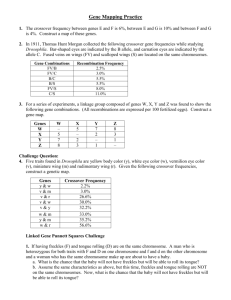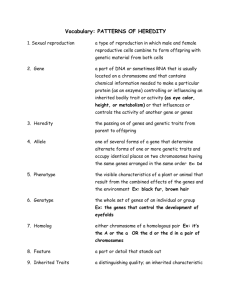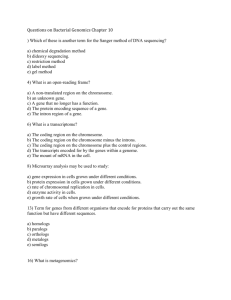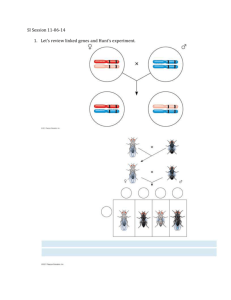traits maternal
advertisement
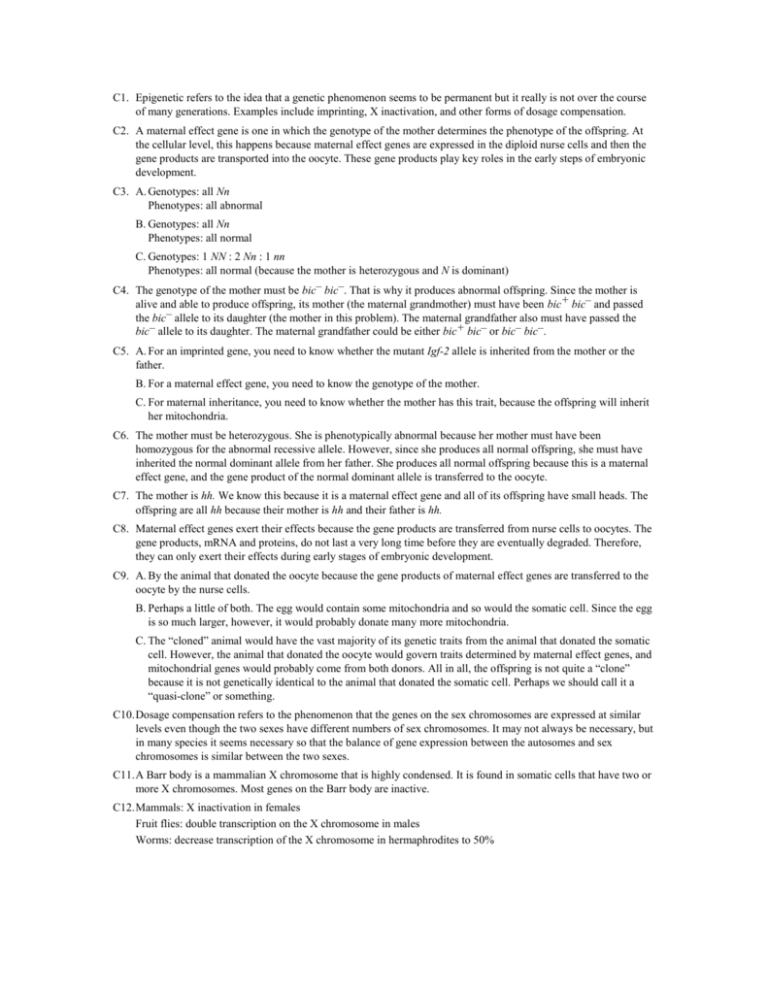
C1. Epigenetic refers to the idea that a genetic phenomenon seems to be permanent but it really is not over the course of many generations. Examples include imprinting, X inactivation, and other forms of dosage compensation. C2. A maternal effect gene is one in which the genotype of the mother determines the phenotype of the offspring. At the cellular level, this happens because maternal effect genes are expressed in the diploid nurse cells and then the gene products are transported into the oocyte. These gene products play key roles in the early steps of embryonic development. C3. A. Genotypes: all Nn Phenotypes: all abnormal B. Genotypes: all Nn Phenotypes: all normal C. Genotypes: 1 NN : 2 Nn : 1 nn Phenotypes: all normal (because the mother is heterozygous and N is dominant) C4. The genotype of the mother must be bic– bic–. That is why it produces abnormal offspring. Since the mother is alive and able to produce offspring, its mother (the maternal grandmother) must have been bic+ bic– and passed the bic– allele to its daughter (the mother in this problem). The maternal grandfather also must have passed the bic– allele to its daughter. The maternal grandfather could be either bic+ bic– or bic– bic–. C5. A. For an imprinted gene, you need to know whether the mutant Igf-2 allele is inherited from the mother or the father. B. For a maternal effect gene, you need to know the genotype of the mother. C. For maternal inheritance, you need to know whether the mother has this trait, because the offspring will inherit her mitochondria. C6. The mother must be heterozygous. She is phenotypically abnormal because her mother must have been homozygous for the abnormal recessive allele. However, since she produces all normal offspring, she must have inherited the normal dominant allele from her father. She produces all normal offspring because this is a maternal effect gene, and the gene product of the normal dominant allele is transferred to the oocyte. C7. The mother is hh. We know this because it is a maternal effect gene and all of its offspring have small heads. The offspring are all hh because their mother is hh and their father is hh. C8. Maternal effect genes exert their effects because the gene products are transferred from nurse cells to oocytes. The gene products, mRNA and proteins, do not last a very long time before they are eventually degraded. Therefore, they can only exert their effects during early stages of embryonic development. C9. A. By the animal that donated the oocyte because the gene products of maternal effect genes are transferred to the oocyte by the nurse cells. B. Perhaps a little of both. The egg would contain some mitochondria and so would the somatic cell. Since the egg is so much larger, however, it would probably donate many more mitochondria. C. The “cloned” animal would have the vast majority of its genetic traits from the animal that donated the somatic cell. However, the animal that donated the oocyte would govern traits determined by maternal effect genes, and mitochondrial genes would probably come from both donors. All in all, the offspring is not quite a “clone” because it is not genetically identical to the animal that donated the somatic cell. Perhaps we should call it a “quasi-clone” or something. C10. Dosage compensation refers to the phenomenon that the genes on the sex chromosomes are expressed at similar levels even though the two sexes have different numbers of sex chromosomes. It may not always be necessary, but in many species it seems necessary so that the balance of gene expression between the autosomes and sex chromosomes is similar between the two sexes. C11. A Barr body is a mammalian X chromosome that is highly condensed. It is found in somatic cells that have two or more X chromosomes. Most genes on the Barr body are inactive. C12. Mammals: X inactivation in females Fruit flies: double transcription on the X chromosome in males Worms: decrease transcription of the X chromosome in hermaphrodites to 50% C13. X inactivation in heterozygous females produces a mosaic pattern of gene expression. Since it occurs randomly during embryonic development, certain patches of tissue have one X chromosome inactivated and other patches have the other X chromosome inactivated. In the case of a female that is heterozygous for a gene that affects pigmentation of the fur, this produces a variegated pattern of coat color. Since it is a random process in any given animal, two female cats will have variation where the orange and black patches occur. A variegated coat pattern could not occur in female marsupials due to X inactivation because the somatic cells preferentially inactivate the paternal X chromosome. C14. X inactivation begins with the counting of Xics. If there are two X chromosomes; one is targeted for inactivation. During embryogenesis, this inactivation begins at the Xic locus and spreads to both ends of the X chromosome until it becomes a highly condensed Barr body. The TsiX gene may play a role in the choice of the X chromosome that remains active. This may occur by its ability to bind to Xist mRNA. The Xist gene, which is located in the Xic region, remains transcriptionally active on the inactivated X chromosome. It is thought to play an important role in X inactivation by coating the inactive X chromosome. After the inactivation is established, it is maintained in the same X chromosome in somatic cells during subsequent cell divisions. In germ cells, however, the X chromosomes are not inactivated so that an egg can transmit either copy of an active (noncondensed) X chromosome. C15. The male is XXY. The person is male due to the presence of the Y chromosome. Because of the counting of Xics, one of the X chromosomes is inactivated to produce a Barr body. C16. A. One B. Zero C. Two D. Zero C17. A. In females, one of the X chromosomes is inactivated. When the X chromosome that is inactivated carries the normal allele, only the defective color blindness allele will be expressed. Therefore, on average, about half of a female’s eye cells are expected to express the normal allele. Depending on the relative amounts of cells expressing the normal versus the color-blind allele, the end result may be partial color blindness. B. In this female, as a matter of chance, X inactivation occurred in the right eye to always, or nearly always, inactivate the X chromosome carrying the normal allele. The opposite occurred in the left eye. In the left eye, the chromosome carrying the color blindness allele was primarily inactivated. C18. The offspring inherited XB from its mother and XO and Y from its father. It is an XXY animal, which is male (but somewhat feminized). C19. The spreading stage is when the X chromosome is inactivated (i.e., condensed) as a wave that spreads outward from Xic. The condensation spreads from Xic to the rest of the X chromosome. The Xist gene is transcribed from the inactivated X chromosome. It encodes an RNA that coats the X chromosome, which subsequently attracts proteins that are responsible for the condensation. C20. Erasure and reestablishment of the imprint occurs during gametogenesis. It is necessary to erase the imprint because each sex will either imprint or not imprint both alleles of a gene. In somatic cells, the two alleles for a gene are imprinted dissimilarly, depending on the sex from which they were inherited. C21. The de novo methylase would be inactive in somatic cells and active in germ cells. Somehow, the methylase must be able to recognize particular DMRs, because we know that some genes are imprinted in males but not females, while other genes are imprinted in females but not males. C22. A person born with paternal uniparental disomy 15 would have Angelman syndrome, because this individual would not have an active copy of the AS gene; the paternally inherited copies of the AS gene are silenced. This individual (if he/she reproduced) would have normal offspring, because he/she does not have a deletion in either copy of chromosome 15. C23. A. Pat and Lynn’s mother is abnormal. We know this because Pat and Lynn both have Angelman syndrome. The AS gene is inactivated in the sperm, so both children must have inherited the deletion from their mother. Therefore, they did not get the gene from their mother, and the gene from their father is normally inactivated. This causes them to have Angelman syndrome. We do not actually know if Pat and Lynn’s mother has AS or PWS. We only know she has the deletion. Their mother could have either AS or PWS depending on whether their mother inherited the deletion from Pat and Lynn’s grandmother or grandfather. B. Pat is a male because he has children with PWS. He transmitted the chromosome carrying the deletion to his two children, and the mother of Pat’s children normally inactivates the PW gene in the egg. Therefore, both children have PWS. As in the answer to part A, we know Lynn is a female because she has a child with AS. C24. In some species, such as marsupials, X inactivation depends on the sex. This is similar to imprinting. Also, once X inactivation occurs during embryonic development, it is remembered throughout the rest of the life of the organism. Again, this is similar to imprinting. X inactivation in mammals is different from genomic imprinting in that it is not sex dependent. The X chromosome that is inactivated could be inherited from the mother or the father. There was no marking process on the X chromosome that occurred during gametogenesis. In contrast, genomic imprinting always involves a marking process during gametogenesis. C25. Extranuclear inheritance is the transmission of genetic material (in eukaryotes) that is not located in the cell nucleus. The two most important examples are mitochondria and plastids. Less common examples are infectious particles that produce traits such as killer paramecia and the sex ratio trait in Drosophila. C26. The term reciprocal cross refers to two parallel crosses that involve the same genotypes of the two parents, but their sexes are opposite in the two crosses. For example: female BBmale bb and a reciprocal cross in which a female bbmale BB. Autosomal inheritance gives the same result because the autosomes are transmitted from parent to offspring in the same way for both sexes. For extranuclear inheritance, the mitochondria and plastids are not transmitted via the gametes in the same way for both sexes. For maternal inheritance, the reciprocal crosses would show that the gene is always inherited from the mother. C27. Extranuclear inheritance does not always occur via the female gamete. Sometimes it occurs via the male gamete. Even in species where maternal inheritance is prevalent, male leakage can also occur. With regard to cytoplasmic inheritance, maternal inheritance is the most common because the female gamete is relatively large and more likely to contain cell organelles. C28. The phenotype of a petite mutant is that it forms small colonies on growth media that contain an energy source that does not require mitochondrial function. These mutants are unable to grow on an energy source that requires mitochondrial function. Since nuclear and mitochondrial genes are necessary for mitochondrial function, it is possible for a petite mutation to involve a gene in the nucleus or in the mitochondrial genome. Neutral petites lack most of their mitochondrial DNA, while suppressive petites usually lack small segments of the mitochondrial genetic material. C29. Paternal leakage means that an organelle is inherited from the paternal parent in a small percentage of cases. If paternal leakage was 3%, then 3% of the time the offspring would inherit the organelles from their father. If the father was transmitting a dominant allele in the organellar genome (and the mother did not), then 3% of the offspring would exhibit the trait. Among a total of 200 offspring, 6 would be expected to inherit paternal mitochondria. C30. The mitochondrial and chloroplast genomes are composed of a circular chromosome found in one or more copies. These copies are located in a region of the organelle known as the nucleoid. The number of genes per chromosome varies from species to species. Mitochondria tend to have fewer genes compared to chloroplasts. See Table 7.3 for examples of the variation among mitochondrial and chloroplast genomes. C31. There is compelling evidence that mitochondria and chloroplasts evolved from an endosymbiotic relationship in which bacteria took up residence within a primordial eukaryotic cell. Throughout evolution, there has been a movement of genes out of the organellar genomes and into the nuclear genome. The genomes of modern mitochondria and chloroplasts only contain a fraction of genes that are necessary for organellar structure and function. Nuclear genes encode most of the proteins that function within chloroplasts and mitochondria. Long ago, these genes were originally in the mitochondrial and chloroplasts genomes but have been subsequently transferred to the nuclear genome. C32. A. Yes. B. Yes. C. No, it is determined by a gene in the chloroplast genome. D. No, it is determined by a mitochondrial gene. C33. Superficially, the tendency to develop this form of leukemia would seem to be inherited from mother to offspring, much like the inheritance of mitochondria. To prove that it is not, one could separate newborn mice from their mothers and place them with mothers that do not carry AMLV. These offspring would not be expected to develop leukemia, even though their mother would. C34. Biparental extranuclear inheritance would resemble Mendelian inheritance in that offspring could inherit alleles of a given gene from both parents. It differs, however, when you think about it from the perspective of heterozygotes. For a Mendelian trait, the law of segregation tells us that a heterozygote passes one allele for a given gene to an offspring, but not both. In contrast, if a parent has a mixed population of mitochondria (e.g., some carrying a mutant gene and some carrying a normal gene), that parent could pass both types of genes (mutant and normal) to a single offspring, because more than one mitochondrion could be contained within a sperm or egg cell. C35. Most of the genes within mitochondria and chloroplasts have been transferred to the nucleus. Therefore, mitochondria and chloroplasts have lost most of the genes that would be needed for them to survive as independent organisms.



